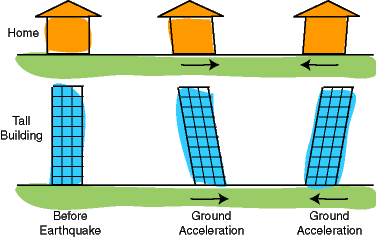Here's a brief introduction to this theory: http://en.wikipedia.org/wiki/Triangle_of_Life
Generally, it's really hard to tell whther this theory is just pseudo science or an unaccepted truth. In different corners of the world with different structure of architectures, it's kind of impossible to set up a universal safe rule. But anyway, we'd like to check it out. So we set up a fishtank, with several model desks inside. And then... we poured different meterials on them. We tried wooden sticks and wooden bars. Considering the roofs may collapse, our final choice of material for roofs is large sheets of ice... In today's experiment, it seems that for our sturdy desks, hiding under them and in the triangle areas are both safe. Sometimes there would be space at the corner of the walls as well. But for the fragile desks, no matter staying under it or beside it, things would always get crushed. However, in the last experiment with ice which was 20mm thick, one of the sturdy tables also get crushed, but still with a triangular space beside it. Tomorrow we'll try another set of experiment with ice frozen with cheesecloth in it, mimicing concrete with steels. Although this experiment is not really accurate due to the models and unreal materials, but still we hope it can reveal a glimpse of the objective laws.
Generally, it's really hard to tell whther this theory is just pseudo science or an unaccepted truth. In different corners of the world with different structure of architectures, it's kind of impossible to set up a universal safe rule. But anyway, we'd like to check it out. So we set up a fishtank, with several model desks inside. And then... we poured different meterials on them. We tried wooden sticks and wooden bars. Considering the roofs may collapse, our final choice of material for roofs is large sheets of ice... In today's experiment, it seems that for our sturdy desks, hiding under them and in the triangle areas are both safe. Sometimes there would be space at the corner of the walls as well. But for the fragile desks, no matter staying under it or beside it, things would always get crushed. However, in the last experiment with ice which was 20mm thick, one of the sturdy tables also get crushed, but still with a triangular space beside it. Tomorrow we'll try another set of experiment with ice frozen with cheesecloth in it, mimicing concrete with steels. Although this experiment is not really accurate due to the models and unreal materials, but still we hope it can reveal a glimpse of the objective laws.


